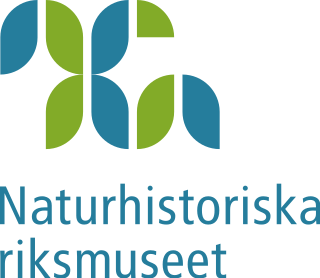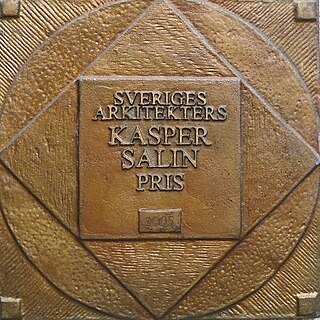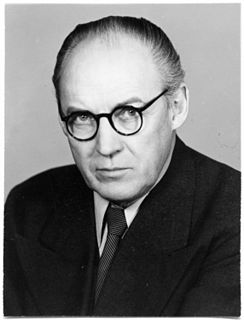Carl Nyrén (11 November 1917 – 6 November 2011) was a Swedish architect. [1]
Contents

Carl Nyrén (11 November 1917 – 6 November 2011) was a Swedish architect. [1]

Nyrén was born in Jönköping, Sweden. Nyrén was the son of Johan Albert and Gertrud Nyrén and grew up in Hovslätt as the youngest of six children. He graduated from the KTH Royal Institute of Technology in Stockholm during 1942. He was first employed by modernist architect Paul Hedqvist. Nyrén was initially influenced by the modernism of Gunnar Asplund (1885–1940). Later in the 1960s, developed towards structuralistic architecture. [2]
During the last two decades of his career, his buildings have were characterized by a romantic, humanistic style.
His office, Nyréns Arkitektkontor AB was founded in 1948. The firm employs architects, interior designers and construction engineers. It remains one of Sweden's leading architectural firms. [3]
Carl Nyrén died on November 6, 2011, five days before what would have been his 94th birthday. [4]

Baron Carl Hårleman was a Swedish architect.

Ivar Justus Tengbom was a Swedish architect and one of the best-known representatives of the Swedish neo-classical architecture of the 1910s and 1920s.

Peter Elof Herman Torsten Folke von Celsing was a Swedish modernist architect.

The Swedish Royal Museum of Natural History, in Stockholm, is one of two major museums of natural history in Sweden, the other one being located in Gothenburg.

The Kasper Salin Prize is a prize awarded annually by Architects Sweden to a Swedish building or building project "of high architectural quality". It is considered the most prestigious architectural prize in the country and has been awarded since 1962. The award is distributed to the building itself and consists of a bronze relief, designed by Swedish architect Bengt Lindroos (1918–2010), which is attached to the building. The prize was funded on the basis of a donation from Kasper Salin (1856–1919) who served as the city architect of Stockholm from 1898 until 1915.

Axel Johan Anderberg was a Swedish architect. He was active from the 1880s to the early 1930s.

Sigurd Lewerentz was a Swedish architect.

Tage William-Olsson was a Swedish architect and chief town planning architect of Gothenburg. He was one of the designers of the Slussen traffic-roundabout infrastructure-project built during 1935 in Stockholm.

Herman Teodor Holmgren was a Swedish architect.
This article covers the architecture of Sweden from a historical perspective.

Ernst Carl Westman was a Swedish architect and interior designer. He was an early adopter of the National Romantic Style, but turned later to the neo-classical style of the 1920s.
The Swedish Swimming Championships are held annually in the Swedish summer in outdoor 50 m pool. The championships sometimes also works as trials for the Summer Olympics, World Championships and European Championships. Swimmers representing Swedish swim teams may participate.

Hakon Ahlberg was a Swedish architect, editor, and author.

Adolf Wilhelm Edelsvärd was a Swedish architect, engineer and military officer.

White Arkitekter is an architectural firm based in Gothenburg, Sweden. It is the biggest firm in Scandinavia, with more than 900 employees. The company has 16 offices in Sweden, Denmark, Norway and England.

Artipelag is an art museum located on the archipelago in Stockholm, Sweden. Opened in June 2012, the building was designed by the late architect Johan Nyrén to fit into the surrounding landscape. The building covers an area of approximately 10,000 square meters and includes 3,000 square meters of art galleries and has 22 acres of surrounding natural scenery.

Carl Gustaf Bergsten was a Swedish architect. He graduated in 1901 from the KTH Royal Institute of Technology and three years later from the Royal Swedish Academy of Fine Arts in Stockholm. A scholarship took him to Germany and to Vienna. He apprenticed with architects Isak Gustaf Clason and Erik Lallerstedt. Bergsten ran his own architectural firm from 1904-35. He was influenced by the National Romantic style and Functionalism. He designed a number of exhibition spaces including Liljevalchs konsthall. For the Norrköping Exhibition of Art and Industry in 1906, Bergsten designed the exhibition's two main buildings the Industrial Hall (Industrihallen) and the Art Exhibition Hall (Konsthallen) as well as the Hunting Pavilion (Jaktpaviljongen).

Gamla Uppsala museum is a historical museum in Gamla Uppsala, in the northern part of Uppsala, Sweden.

Knut Wilhelm Malcolm Beckeman was a Swedish architect.